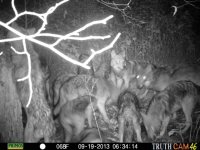You include a lot of "might be"'s there. As you point out, there are a pile of factors that can explain a pile of the dominoes that follow, perhaps due to climate change, perhaps not. Case in point...I lived in Westchester Co NY and it was not unusual to have several deer eating on the lawn 5' from the front door when I left for work at 6am. It was illegal to hunt anything with a gun in the entire county. A few years later, we started to see coyotes. I'm not a biologist but do recall rules on peaks and valleys on ruffed grouse and rabbit populations. The population increases, the predators move in a few years later, their food supply goes down and the predator population dies off for lack of food. Then it starts again.
I can't buy into the easy excuse of climate change for new bugs and animal behavior. We could put all our efforts down that road and then figure out that there are other factors.
I think it is complex, inter-related, and always changing, that's the thought in my last sentence:
The combinations of climate change, biodiversity and habitat alterations are driving those changes.
That said, it is undeniably true that invasive plants and animals expand or contract their ranges with the climate they are adapted to. The introduction of an invasive, and its ability to survive
and spread are three different things.
I could turn a Florida gator loose in my woods, but it won't survive.
There are areas where a transplanted conifer will survive and grow, but it is very rare to see a successful natural germination of any seeds dropped. The soil, moisture, shading, seasonal temperature versus daylight duration, the absence of a bird that opens the cone, or competing species conditions don't favor that.
Marginal organisms (for the local climate) such as Hemlock Wooly Adelgid might invade my woods if the temperature warms enough to allow that. It is already common south of here and along the coast where temperatures are moderated by the ocean.
If that happens, there will be hemlock mortality, which in turn alters the area biodiversity. Those things which depend on hemlock will be impacted, and that which depends on the affected, will be also be impacted in a chain reaction.
Habitat alterations also include the after-effects of pollutants. Through mechanisms such as acid rain, the soils and water become more or less amenable to various species of plants. Over time, acid rain changes forest plant species composition, which in turn changes support for forest dwelling animals, which in turn has an impact on plant use. Changes in plant use lead to changes in plant population composition which benefits some things and is detrimental to others.
There are endless feedback loops. The overall complexity is such that no one has even half of the answers to the known questions.

